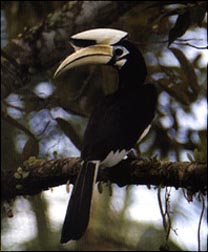Restoring conservation forests in northern Thailand and the monitoring of frugivorous birds
by David Blakesley and Stephen Elliott, OBC Bulletin 31, June 2000
Although Thailand has one of the most extensive systems of conservation areas in Asia, deforestation remains a serious problem. Since establishing the country's first national parks in the 1960s, Thailand's forest cover has been reduced from 53% of the country (1) to about 22.8% or 111,010 km2 (2). Unofficial estimates, however, put Thailand's forest cover at less than 20% (3). In 1989 the government banned commercial logging; a ban that remains in force today. Nevertheless, the annual rate of forest loss remains at approximately 1%. Illegal logging and agricultural expansion are the main causes of deforestation. Consequently, today large parts of the country, including extensive areas in national parks and wildlife sanctuaries, are covered in degraded forest or grasslands dominated by herbaceous weeds. Over most of northern Thailand, large vertebrates such as wild elephants, rhinos and wild cattle are either gone or on the brink of disappearing and many of the larger bird species such as hornbills are barely surviving. In the south, there is perhaps no better example than the current threat to the last remaining known population of Gurney's Pitta Pitta gurneyi at Khao Nor Chuchi, which is discussed elsewhere in this Bulletin.
Black-and-yellow Broadbill, © David and John Cooper
Restoring conservation forests
A positive development in Thailand in recent years has been the rapid increase in public awareness of the problems caused by deforestation. It is now generally accepted that further forest loss will cause more extreme floods and droughts, damage to watersheds, loss of biodiversity and impoverishment of rural communities. Complete protection of all remaining forest is unlikely, due to economic and legal constraints. Therefore, to maintain the current level of forest cover, or indeed to increase it, deforestation must be balanced by reforestation.
This need is reflected in the National Forest Policy, which stipulates that 40% of the country should be forested, including 25% designated as conservation forest. In an attempt to work towards this target, many former logging concessions were designated as national parks or wildlife sanctuaries after the logging ban. This enlarged the protected areas system to 91 national parks and 42 wildlife sanctuaries, covering more than 73,000 km2 or 14.3% of the country (as of 24/12/99, data from the Royal Forest Department). Consequently, many conservation areas were already extensively deforested before they acquired protected status. If such areas are to fulfil their statutory functions of wildlife conservation and watershed protection, the native forest must be restored.
Rehabilitation and restoration of degraded ecosystems are extremely important components of in situ conservation, as identified in the Convention on Biodiversity, but research on the biological aspects of the problem has been neglected. Attempts to recreate natural forest ecosystems are hindered by their complexity. Any individual forest type may contain several hundred tree species, each of which may have evolved intricate relationships with hundreds of other organisms, such as herbivores, pollinators and seed-dispersers. Restoration of natural forest ecosystems, therefore, requires a vast amount of ecological information, of which only a small fraction is currently known. We need to understand how forests regenerate naturally, identify the factors limiting regeneration and develop effective methods to counteract them and thus accelerate regeneration, for example through planting tree seedlings.
The Framework Species Method developed by Nigel Tucker and his colleagues in Queensland, Australia in the late 1980s (4-6) is a practical method for accelerating forest regeneration. Native tree species that can rapidly shade out weeds and are attractive to seed-dispersing animals are planted in degraded sites. The sites are enhanced for wildlife, by incorporating rotting logs, nest boxes for birds and other wildlife resources. Once established, the trees provide fruit, nectar or perching sites that attract seed-dispersing birds and mammals from neighbouring forest areas. Planting trees begins the process of biodiversity recovery, with wildlife completing the process. In northern Thailand, the Forest Restoration Research Unit (FORRU) is carrying out research to determine whether a similar approach will work there. Researchers at the unit have developed propagation methods to grow a wide range of native forest tree species in nurseries and test their performance and ability to accelerate the return of biodiversity in experimental plots (7).
The role of frugivorous birds
Whilst most forest birds probably consume some fruit, 17 families contain species that rely on fruit for a large part of their diet. In a recent comprehensive review of this subject, Corlett (8) reported that the most important of these families in good forest are hornbills, barbets, broadbills, fruit-pigeons, muscapids, bulbuls, white-eyes, laughingthrushes, babblers and flowerpeckers. However, in degraded forest, or the restoration plots being established by FORRU, many of these frugivorous species are absent. Indeed, many species, such as hornbills and fruit-pigeons are unlikely to venture into degraded areas newly planted with young trees. Furthermore, since most large frugivores have become extirpated, we have to look towards other, smaller fruit-eating species, tolerant of degraded areas to disperse seed. These primarily include bulbuls and mynahs, but also jays and magpies; thrushes, robins and chats; white-eyes; laughingthrushes and flowerpeckers. Surprisingly, many of these are insectivores which also take fruit. Replanted areas where the canopy has closed that are situated close to good forest might support green pigeons, Oriental Pied Hornbill Anthracoceros albirostris and possibly wood pigeons.
Oriental Pied Hornbill, © Christian Artuso
Role of bird watchers
Restoration of natural forest ecosystems for wildlife conservation is becoming a very important component of the biodiversity conservation agenda. Recently, an international meeting was held in Chiang Mai, Thailand to draft a research agenda for the restoration of tropical forests for wildlife conservation in South-East Asia. Two of the areas identified as requiring urgent attention were seed-dispersal and plantation design. One question that immediately springs to mind is which tree species can attract frugivorous birds from forest into degraded areas? This can be studied by noting the species and numbers of birds visiting fruiting trees in good forest. Indeed, FORRU has carried out initial studies in this area; one such study funded by an OBC conservation grant. However, a small research unit such as FORRU does not have the staff or resources to carry out extensive studies. Can you help? On a recent visit to Doi Inthanon, early on a February morning, interesting birds eating fruit in trees included migrant thrushes such as Grey-sided Thrush Turdus feae and Eye-browed Thrush Turdus obscurus, Purple Cochoa Cochoa purpurea and Yellow-bellied Flowerpecker Dicaeum chrysorrheum along with Wedge-tailed Green Pigeons Treron sphenura and several bulbul species. Information on species and numbers of birds and a description of the tree (preferably with a photo), or better still a dried specimen of the leaves and fruits, would be very useful for FORRUs research programme. Observations of birds consuming fruits are made all the time by birders in the region, who may not appreciate their value. Records of birds visiting severely degraded forests or restoration plots (not necessarily to consume fruits) would also be very valuable. Why? Because we need to plant tree species that attract seed-dispersing birds into degraded areas.
References
Bhumibamon, S., 1986. The environmental and socio-economic aspects of tropical deforestation: a case study of Thailand. Department of Silviculture, Faculty of Forestry, Kasetsart University. 102 pp.
FAO, 1997. State of the World's Forests 1997.
Leungaramsri, P. and Rajesh, N., 1992. The Future of People and Forests in Thailand After The Logging Ban. Project For Ecological Recovery, Bangkok, Thailand. 202 pp.
Goosem, S. and Tucker, N., 1995. Repairing the Rainforest. Cassowary Publications, Cairns, Australia.
Tucker, N. and Murphy, T., 1997. The effects of ecological rehabilitation on vegetation recruitment: some observations from the Wet Tropics of North Queensland. Forest Ecology and Management 99: 133-152.
Lamb. D., Parrotta, J., Keenan R. and Tucker, N., 1997. Rejoining habitat fragments: restoring degraded forest lands. pp. 366-385 in Laurance, W. F. and Bierregaard, R.O. (eds), Tropical Forest Remnants: Ecology, Management and Conservation of 7 Forest Restoration Research Unit, 1998.
Forests for the future: growing and planting native trees for restoring forest ecosystems. Biology Department, Science Faculty, Chiang Mai University, Thailand.
Corlett, R. T., 1998. Frugivory and seed dispersal by vertebrates in the Oriental (Indomalayan) Region. Biol. Rev. 73: 413-448. Fragmented Communities.
See Sales for prices and availability of Bulletin past issues Return to Bulletin index


